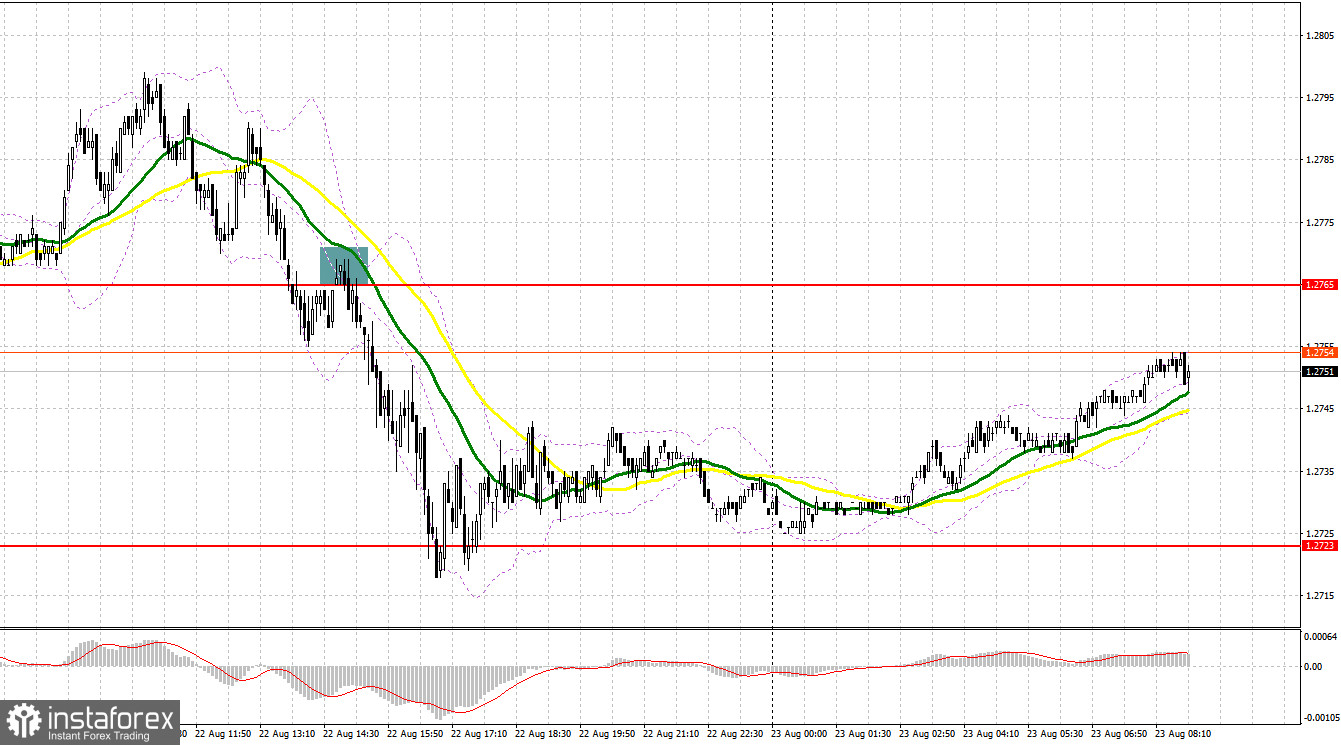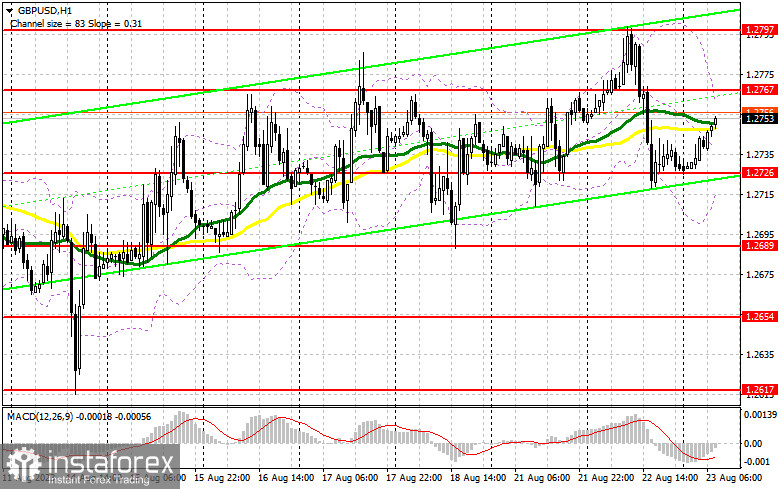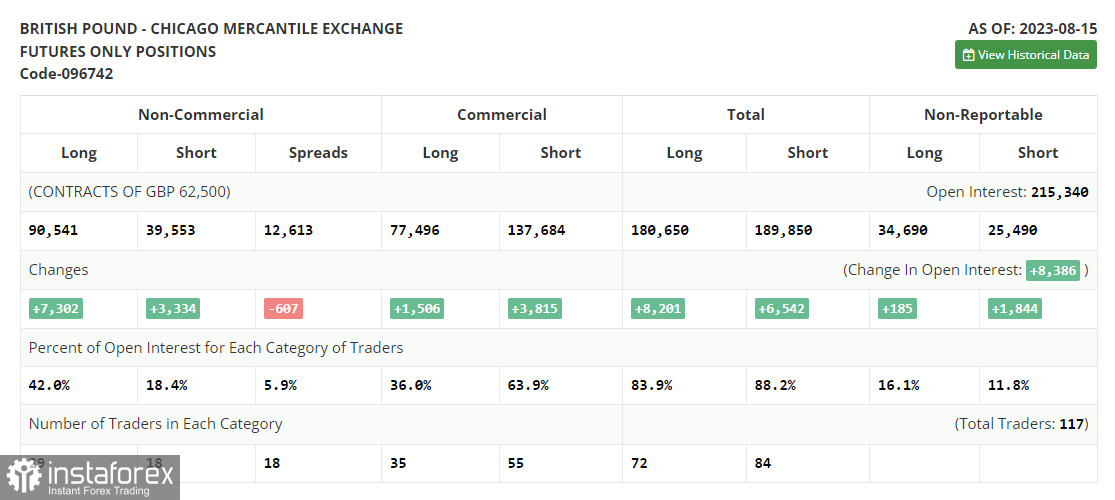Yesterday, the pair formed several good signals to enter the market. Let's analyze what happened on the 5-minute chart. In my morning review, I mentioned the level of 1.2783 as a possible entry point. Growth and false breakout at this mark generated a good sell signal, but there was no major fall. During the US session, a false breakout and retest of 1.2765 gave a good sell signal. As a result, the pair fell by more than 40 pips.

For long positions on GBP/USD:
Today, there are quite important UK reports on the Manufacturing PMI, Services PMI and composite PMI. An even greater contraction in the services sector may seriously affect the bulls' positions, which will lead to a downtrend. In this case, a false breakout near the new support level at 1.2726 will form a good entry point for long positions in hopes of updating the the nearest resistance level at 1.2767, which was formed yesterday. A breakout and consolidation above this range will reinforce the pound sterling, allowing it to reach new weekly highs at 1.2797. The ultimate target remains the area of 1.2847 where I will be locking in profits. If GBP/USD declines and there is no buying activity at 1.2726, the pound will be under pressure. In this case, only the defense of the 1.2689 area and its false breakout would give a signal for opening long positions. I will open long positions immediately on a rebound from the monthly low of 1.2654, keeping in mind a daily correction of 30-35 pips.
For short positions on GBP/USD:
I expect new sellers to appear only in the area of the nearest resistance level at 1.2767, which was formed yesterday. Unsuccessful consolidation at this level after disappointing PMI reports will produce a sell signal with a prospect of falling to the intermediate support level at 1.2726, which I'm not counting on. A breakout of this level and its upward retest would significantly dent the bulls' positions, offering a chance for a more substantial decline towards the low of 1.2689. The ultimate target is the low at 1.2654 where I will be locking in profits. If GBP/USD trends upward during the European session and if no selling activity is observed at 1.2767, which is possible, given how stubborn the pound is even as the US dollar firmed across the board, the bulls will regain control of the situation. In such a scenario, a false breakout near the next resistance at 1.2797 would provide an entry point for going short. If there is no downward movement there, I would sell the pound right on a rebound from 1.2847, keeping in mind an intraday correction of 30-35 pips.

COT report:
The Commitments of Traders (COT) report for August 15 recorded an increase in both long and short positions. Traders built up positions after the UK GDP report, which was better than economists' expectations. US inflation cooling also had an impact on the balance of power, supporting the pound, as well as persistent core pressure in the UK. Federal Reserve officials will hold their annual Jackson Hole symposium later this week, which could lead to even more strengthening of the British Pound in the short term. The focus will be on Fed Chair Jerome Powell's speech about US monetary policy. As before, the optimal strategy is to buy the pound on dips, as the difference in the policies of the central banks will affect the prospects of the US dollar, putting pressure on it. The latest COT report indicates that long positions of the non-commercial group of traders rose by 7,302 to 90,541, while short positions jumped by 3,334 to 39,553. As a result, the spread between long and short positions narrowed by 607. The weekly closing price dropped to 1.2708 compared to the prior value of 1.2749.

Indicator signals:
Moving Averages
Trading is taking place around the 30-day and 50-day moving averages, indicating a sideways market trend.
Please note that the time period and levels of the moving averages are analyzed only for the H1 chart, which differs from the general definition of the classic daily moving averages on the D1 chart.
Bollinger Bands
If GBP/USD falls, the indicator's lower border near 1.2726 will serve as support.
Description of indicators:
• A moving average of a 50-day period determines the current trend by smoothing volatility and noise; marked in yellow on the chart;
• A moving average of a 30-day period determines the current trend by smoothing volatility and noise; marked in green on the chart;
• MACD Indicator (Moving Average Convergence/Divergence) Fast EMA with a 12-day period; Slow EMA with a 26-day period. SMA with a 9-day period;
• Bollinger Bands: 20-day period;
• Non-commercial traders are speculators such as individual traders, hedge funds, and large institutions who use the futures market for speculative purposes and meet certain requirements;
• Long non-commercial positions represent the total number of long positions opened by non-commercial traders;
• Short non-commercial positions represent the total number of short positions opened by non-commercial traders;
• The non-commercial net position is the difference between short and long positions of non-commercial traders.





















